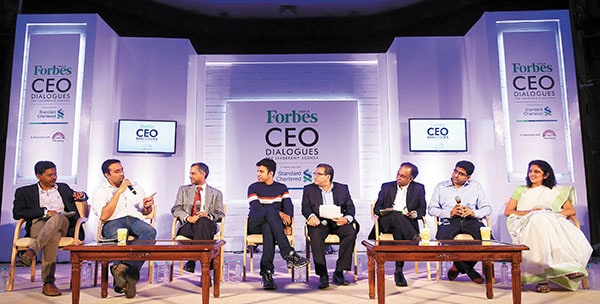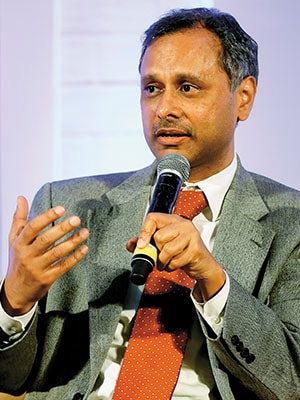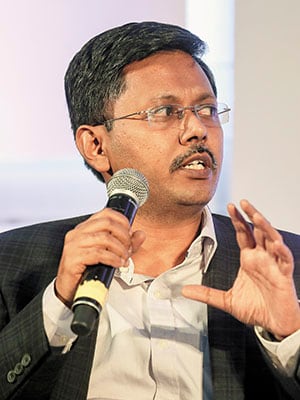
Bengaluru: Climbing up the innovation ladder
With a vibrant startup culture and robust venture capital funding, the Garden City is on the cusp of becoming a global innovation hub. It only needs some big institutes and an efficient mentor ecosystem in place
Over the last decade, Bengaluru has moved up the value chain, from BPO hub to the Silicon Valley of India. Multiple reports and studies point out that it is the preferred destination for homegrown startups and venture capital funding. The city’s IT-services legacy, talent pool and diverse culture have contributed to building brand Bengaluru. However, despite all that, it is still far from becoming a global innovation hub.
This problem was the subject of the latest round of the Forbes India CEO Dialogues: The Leadership Agenda, held at the Indian Institute of Management (IIM)-Bangalore, in front of an audience of the B-school’s students. SD Shibulal, co-founder, Infosys Ltd, Meena Ganesh, CEO and MD, Portea Medical, Srikrishna Ramamoorthy, partner, Unitus Seed Fund, Ganapathy Venugopal, CEO, Axilor Ventures, Rajiv Srivatsa, co-founder, Urban Ladder, Shashank ND, founder and CEO, Practo, and Manish Gupta, VP and director, Xerox Research Centre India, shed light on the infrastructure issues plaguing the city and the lack of big institutes there that can foster innovation. Excerpts from the discussion moderated by Sourav Majumdar, editor, Forbes India:
Sourav Majumdar: Startups foster innovation and Bengaluru is the startup capital of India. What is so special about the city and is it enough?
Meena Ganesh: There are a few things about Bengaluru which have really worked [for the city]. One is the kind of talent pool that it has attracted. Over the last 20 years, it has attracted a lot of technology talent, both in software and hardware. Having that kind of capability in one city has helped. Secondly, it is a great melting pot of people of different cultures. It also has a good mix of people with business backgrounds.
Innovations are happening in institutions like the Indian Institute of Technology [IIT] that exist in other cities. Unfortunately, Bengaluru does not have an institute of that calibre. Of course, there is the Indian Institute of Science [IISc] and IIM, but they are not of the size and scale that, say, an IIT offers in terms of talent.
SD Shibulal: When we started Infosys in 1981, the world was a completely different place. Bengaluru was a sleepy town. All the shops used to close at 12 pm and open at 4 pm… so, afternoons were for siesta. The world has changed since. When we started Infosys, it was a time of constraints and not a time of entrepreneurship. Infosys was probably one of the first entrepreneurial organisations to be built. Also, there was no funding at that time, there were no incubators; it was the regime of the Licence Raj.
Today, there are about a hundred companies which have research and development [R&D] centres in Bengaluru that are creating talent. But we still have a long way to go. We still struggle with infrastructure.
Srikrishna Ramamoorthy: In terms of statistics, of the 22 companies that we [Unitus Seed Fund] have invested in, 15 to 16 are based out of Bengaluru. It [the city] has lent itself very well to startups. And the startup culture has fostered because you are seeing success as well. The general workforce and managerial talent have also played a role. Nearly 65 to 70 percent of the venture capital money that comes into India comes to Bengaluru. The big draw for the longest time has been the weather, and it still remains a big draw!
Majumdar: What is the key change that is driving this huge pool of talent and keeping it going?
Shibulal: There has been a change in mindset. People with steady jobs are willing to give up their jobs and do something on their own. This was not the case 30 years ago. So, there is a fundamental change in their thinking, their ability to take risks and their ability to accept entrepreneurship. All these factors have changed.
Majumdar: Manish, you are part of a global corporation [Xerox Research Centre India] which has a research arm in the city and there are many others like you. How much of an innovation mindset are you witnessing in some of these centres?
Manish Gupta: A lot of innovation [R&D] at these global firms has been invisible to the general public. And very rightly so. There were a lot of very interesting things happening for the Indian market, but they never converted from [being] very interesting ideas to real innovations. If you are working for a multinational corporation and if you come up with an idea which has no real relevance to the US markets, they have trouble understanding those ideas. There is a lot of potential for some of these R&D centres to work more closely with startups, especially on ideas that can help transform India.
Majumdar: It is wonderful to see startups taking to mentoring and accelerator initiatives in the city. Ganapathy, how are you looking at it from the perspective of somebody who is helping them scale up to the next stage?
Ganapathy Venugopal: Going by the experience of the last one year and having seen entrepreneurs working from early stages, two things clearly stand out: A vast majority of them come up with an opinion or an idea, which according to them is very good. However, the whole market validation process of seeking evidence if the customer is as excited about it as I am as an entrepreneur is not as widespread as it should be.
The other thing lacking is diversity. For any ecosystem to thrive, even at the ideation level, we need ideas to solve problems across many areas. When I look at the entrepreneurial activity, the investment activity, and I look at some of the problems, there are glaring examples in areas like health care, where it is just not possible to solve the problems by taking the same trajectory.
Majumdar: This is a valid point… whether enough problems are being solved by way of startups. When we look at innovation in Bengaluru and in India, is it a me-too thing, which is aimed at valuation and exit? Because it seems to me, in some cases, that is the guiding principle.
Ganesh: For every very innovative idea, there are bound to be 10 or 20 people who want to do the same thing. That doesn’t take away from the fact that there are a lot of very different areas that people are working on. What happens is that one particular area starts to catch the attention of investors, and everybody wants to jump on to that. I think there is a fair bit of diversity in the kind of problems that people are working on. The problem is not just the entrepreneurs but also that the investors follow a herd mentality. It’s not the lack of ideas but herd mentality that can affect entrepreneurs and investors.
Shashank ND: There are different types of entrepreneurs, but the ones who I have seen succeed are the ones who don’t really care about whether investors like it [their ideas] or don’t like it… whether it’s fundable or not fundable. It’s a very important thing for entrepreneurs to follow their dreams and their gut, and build a team that believes in the same vision. It doesn’t matter if the investors or advisors don’t really see it that way. Eventually, they will come around. If you only start companies that investors will fund, when they stop funding, you will stop working. And that cannot be the case.
Rajiv Srivatsa: Going back to the problem statement, there is this thing called product market fit. And that is the market must be willing to pay a particular price for something that we put out. Right now, too many startups are buying something for Re 1 and selling for 50 paisa. And that is never going to be sustainable.
Shibulal: The point I want to make is that the spread of applications is still skewed towards ecommerce and aggregation. As a country, we need innovation in all verticals—whether it is retail, supply chain, health care, education or clean-tech. The interest today is much more towards one segment. As a country, we need fundamental IP [intellectual property]. Our investment in research is very low. As a country, we invest 0.8 percent of our GDP in R&D, whereas China invests 1.8 to 2 percent.
We don’t have any investment going into the lab. In fact, today, universities are finding it hard to find PhD students because it is not a very lucrative environment. The infrastructure is not there and, most of the time, the investments are lacking. This is an area where we will have to invest going forward.
Ganapathy: Even with 0.8 percent of the GDP spent on R&D, there is a huge challenge in getting the research out of the labs and into the market. And Bengaluru is a very good example of this. Bengaluru has a constellation of all the national level institutions [such as the IISc and others] and also others like the Narayana Hrudayalaya and the National Institute of Mental Health and Neuroscience [NIMHANS] where innovations could actually be tested. This is one big area that we need to look into. Building the institutional bridges is clearly required.
Shashank: The constraints that India has in terms of cost and accessibility give you a huge leverage in terms of a startup to innovate. For example, we have a tablet that can do multiple things for a doctor in areas where there is no internet connection and no power. So, a doctor can treat patients without having electricity. We can definitely innovate down the pyramid and find innovative solutions. But, I also see the need for Indian entrepreneurs and the Indian ecosystem to try and innovate so that we can take products outside the country. And that’s started to happen.
Srivatsa: Shashank’s point is if we can build products that stand out in the world. See China, which is completely product driven. There is no Facebook or Gmail because they have their own [sites]. In India, the Facebook of India is Facebook and the Google of India is Google. If you want to really up the level of product and design thinking, we should challenge the world.
Majumdar: I think what Rajiv is talking about is whether there will be a huge game-changing innovation in the product space coming out of India like a Facebook or Google.
Srivatsa: I believe it is possible. In the next five to 10 years, we have to do a crazy amount of work and connect with the right mentor ecosystems. For example, what differentiates Silicon Valley [from the rest] is that it has a fantastic Stanford [University] mentor ecosystem. IIM-B could be like that here. If you see, Israel has a much better ecosystem for startups compared to Bengaluru. So, we have to fill a few gaps to get to that next level.
Ramamoorthy: I think there is a lot of innovation and money to be made if you are investing in solving problems for India. Clearly, education and health care fall squarely into that space, and you might want to think about areas like agriculture as well.
Majumdar: Manish, is there enough pathbreaking innovation that you see in Bengaluru or is it more incremental in nature?
Gupta: I would say a lot of the innovation tends to be incremental. I have seen a lot of pathbreaking ideas come out of various research labs, but I don’t think those get converted into real innovation. The real innovation is when you have success in the market and that I believe is going to change. Some of these startups may look incremental to begin with, but over a period of time as they start to solve real customer problems, they will be forced to innovate so much that you will see groundbreaking ideas as well.
Majumdar: Shibulal, when we talk about innovation, there is also the issue of fear of failure. Does it still exist in Indian society?
Shibulal: The fear of failure has considerably come down among the young generation. The society has also accepted that fact. It is well acceptable among parents and teachers too. But we still lag behind in the mentorship space. We don’t have enough mentors in the startup system. If you look at Silicon Valley, there are a lot of mentors who share their success [stories] and failures with newcomers and help them understand the space better.
Ganesh: I agree with Shibu [Shibulal] that people nowadays hold it as a badge of pride that they have failed. At the social level, we are starting to overcome that fear of failure, but at the regulatory level, it is impossible to shut down a company even today. It is really difficult to do that. So, those concerns are still there and that has not kept pace like the way other factors have evolved in the startup space.
(This story appears in the 30 November, -0001 issue of Forbes India. To visit our Archives, click here.)







